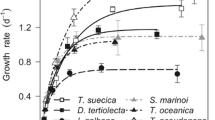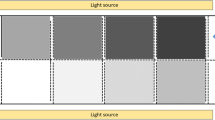Abstract
In the deep, cooler layers of clear, nutrient-poor, stratified water bodies, phytoplankton often accumulate to form a thin band or “deep chlorophyll maximum” (DCM) of ecological importance. Under such conditions, these photosynthetic microorganisms may be close to their physiological compensation points and to the boundaries of their ecological tolerance. To grow and survive any resulting energy limitation, DCM species are thought to exhibit highly specialised or flexible acclimation strategies. In this study, we investigated several of the adaptable ecophysiological strategies potentially employed by one such species, Chlamydomonas acidophila: a motile, unicellular, phytoplanktonic flagellate that often dominates the DCM in stratified, acidic lakes. Physiological and behavioural responses were measured in laboratory experiments and were subsequently related to field observations. Results showed moderate light compensation points for photosynthesis and growth at 22°C, relatively low maintenance costs, a behavioural preference for low to moderate light, and a decreased compensation point for photosynthesis at 8°C. Even though this flagellated alga exhibited a physiologically mediated diel vertical migration in the field, migrating upwards slightly during the day, the ambient light reaching the DCM was below compensation points, and so calculations of daily net photosynthetic gain showed that survival by purely autotrophic means was not possible. Results suggested that strategies such as low-light acclimation, small-scale directed movements towards light, a capacity for mixotrophic growth, acclimation to low temperature, in situ exposure to low O2, high CO2 and high P concentrations, and an avoidance of predation, could combine to help overcome this energetic dilemma and explain the occurrence of the DCM. Therefore, corroborating the deceptive ecophysiological complexity of this and similar organisms, only a suite of complementary strategies can facilitate the survival of C. acidophila in this DCM.








Similar content being viewed by others
References
Arvola L, Salonen K, Kankaala P, Lehtovaara A (1992) Vertical distributions of bacteria and algae in a steeply stratified humic lake under high grazing pressure from Daphnia longispina. Hydrobiol 229:253–269
Beckmann A, Hense I (2004) Torn between extremes: the ups and downs of phytoplankton. Ocean Dyn 54:581–592. doi:10.1007/s10236-004-0103-x
Bissinger V, Jander J, Tittel J (2000) A new medium free of organic carbon to cultivate organisms from extremely acidic mining lakes (pH 2.7). Acta Hydrochim Hydrobiol 28:310–312
Bright DI, Walsby AE (2000) The daily integral of growth by Planktothrix rubescens calculated from growth rate in culture and irradiance in Lake Zurich. New Phytol 146:301–316
Cassin PE (1974) Isolation, growth, and physiology of acidophilic Chlamydomonads. J Phycol 10:439–447
Clegg MR, Maberly SC, Jones RI (2003) The effect of photon irradiance on the behavioral ecology and potential niche separation of freshwater phytoplanktonic flagellates. J Phycol 39:650–662
Clegg MR, Maberly SC, Jones RI (2004a) Dominance and compromise in freshwater phytoplanktonic flagellates: the interaction of behavioural preferences for conflicting environmental gradients. Funct Ecol 18:371–380
Clegg MR, Maberly SC, Jones RI (2004b) Chemosensory behavioural response of freshwater phytoplanktonic flagellates. Plant Cell Environ. 27:123–135
Clegg MR, Maberly SC, Jones RI (2007) Behavioral response as a predictor of seasonal depth distribution and vertical niche separation in freshwater phytoplanktonic flagellates. Limnol Oceanogr 52:441–455
Coon TG, Lopez M, Richerson PJ, Powell TM, Goldman CR (1987) Summer dynamics of the deep chlorophyll maximum in Lake Tahoe. J Plankt Res 9:327–344
Crawford DW (1992) Metabolic cost of motility in planktonic protists: theoretical considerations on size scaling and swimming speed. Microb Ecol 24:1–10
Cullen JJ (1982) The deep chlorophyll maximum: comparing vertical profiles of chlorophyll a. Can J Fish Aquat Sci 39:791–803
Cullen JJ, MacIntyre JG (1998) Behavior, physiology and the niche of depth-regulating phytoplankton. In: Anderson DM, Cembella AD, Hallegraeff GM (eds) Physiological ecology of harmful algal blooms. Springer, Berlin, pp 559–579
Diehn B, Feinleib ME, Haupt W, Hildebrand E, Lenci F, Nultsch W (1977) Terminology of behavioral responses of motile microorganism. Photochem Photobiol 26:559–560
Doi H, Kikuchi E, Hino S, Itoh T, Takagi S, Shikano S (2003) Seasonal dynamics of carbon stable isotope ratios of particulate organic matter and benthic diatoms in strongly acidic Lake Katanuma. Aquat Microb Ecol 33:87–94
Fang X, Stefan HG (1999) Projections of climate change effects on water temperature characteristics of small lakes in the contiguous US. Climatic Change 42:377–412
Feinleib ME, Curry GM (1971) The relationship between stimulus intensity and oriented phototactic response (topotaxis) in Chlamydomonas. Physiol Plant 25:346–352
Fennel K, Boss E (2003) Subsurface maxima of phytoplankton and chlorophyll: steady-state solutions from a simple model. Limnol Oceanogr 48:1521–1534
Gaevsky NA, Zotina TA, Gorbaneva TB (2002) Vertical structure and photosynthetic activity of Lake Shira phytoplankton. Aquat Ecol 36:165–178
Geider RJ, Osborne BA (1989) Respiration and microalgal growth—a review of the quantitative relationship between dark respiration and growth. New Phytol 112:327–341
Geider RJ, Osborne BA, Raven JA (1985) Light dependence of growth and photosynthesis in Phaeodactylum tricornutum (Bacillariophyceae). J Phycol 21:609–619
Gerloff-Elias A, Spijkerman E, Schubert H (2005a) Light acclimation of Chlamydomonas acidophila accumulating in the hypolimnion of an acidic lake (pH 2.6). Freshwater Biol 50:1301–1314. doi:10.1111/j.1365-2427.2005.01400.x
Gerloff-Elias A, Spijkerman E, Pröschold T (2005b) Effect of external pH on the growth, photosynthesis and photosynthetic electron transport of Chlamydomonas acidophila Negoro, isolated from an extremely acidic lake (pH 2.6). Plant Cell Environ 28:1218–1229
Gervais F (1997) Diel vertical migration of Cryptomonas and Chromatium in the deep chlorophyll maximum of a eutrophic lake. J Plankton Res 19:533–550
Gervais F, Siedel U, Heilmann B, Weithoff G, Heisig-Gunkel G, Nicklisch A (2003) Small-scale vertical distribution of phytoplankton, nutrients and sulphide below the oxycline of a mesotrophic lake. J Plankton Res 25:273–278
Heaney SI, Eppley RW (1981) Light, temperature and nitrogen as interacting factors affecting diel vertical migrations of dinoflagellates in culture. J Plankt Res 3:331–344
Huisman J, Pham Thi NN, Karl DM, Sommeijer B (2006) Reduced mixing generates oscillations and chaos in the oceanic deep chlorophyll maximum. Nature 439:322–325. doi:10.1038/nature04245
Hurley MA (1996) A statistical method to identify different survival patterns of culturable microbes in environmental microcosms. J Microbiol Methods 27:199–205
Jeffrey SW, Humphrey GF (1975) New spectrophotometric equations for determining chlorophylls a, b, c1 and c2 in higher plants, algae and natural phytoplankton. Biochem Physiol Pflanzen 167:191–194
Jones RI (1993) Phytoplankton migrations: patterns, processes and profits. Ergebnisse Limnol 39:67–77
Kamykowski D (1981) Laboratory experiments on the diurnal vertical migration of marine dinoflagellates through temperature gradients. Marine Biol 62:57–64
Kamykowski D, Yamazaki H (1997) A study of metabolism-influenced orientation in the diel vertical migration of marine dinoflagellates. Limnol Oceanogr 42:1189–1202
Karakas G, Brookland I, Boehrer B (2003) Physical characteristics of acidic mining lake 111. Aquat Sci 65:297–307. doi:10.1007/s00027-003-0651-z
Kessler K, Lampert W (2004) Fitness optimization of Daphnia in a trade-off between food and temperature. Oecologia 140:381–387. doi:10.1007/s00442-004-1592-5
Kessler JO, Hill NA, Häder DP (1992) Orientation of swimming flagellates by simultaneously acting external factors. J Phycol 28:816–822
Kirk JTO (1994) Light and photosynthesis in aquatic ecosystems. Cambridge University Press, Cambridge
Klausmeier CA, Litchman E (2001) Algal games: the vertical distribution of phytoplankton in poorly mixed water columns. Limnol Oceanogr 46:1998–2007
Latta LC IV, O’Donnell RP, Pfrender ME (2009) Vertical distribution of Chlamydomonas changes in response to grazer and predator kairomones. Oikos 118:853–858. doi:10.1111/j.1600-0706.2009.17352.x
Laybourn-Parry J (2002) Survival mechanisms in Antarctic lakes. Phil Trans R Soc Lond B 357:863–869. doi:10.1098/rstb.2002.1075
Loe LE, Bonenfant C, Mysterud A, Severinsen T, Oritsland NA, Langvatn R, Stien A, Irvine RJ, Stenseth NC (2007) Activity pattern of arctic reindeer in a predator-free environment: no need to keep a daily rhythm. Oecologia 152:617–624. doi:10.1007/s00442-007-0681-7
Longhurst AR (1976) Interactions between zooplankton and phytoplankton profiles in the eastern tropical Pacific Ocean. Deep-Sea Res 23:729–754
McCullagh P, Nelder JA (1983) Generalized linear models. Chapman and Hall, London
Moll RA, Brahce MZ, Peterson TP (1984) Phytoplankton dynamics within the subsurface chlorophyll maximum of Lake Michigan. J Plankton Res 6:751–766
Padisak J, Krienitz L, Koschel R, Nedoma J (1997) Deep-layer autotrophic picoplankton maximum in the oligotrophic Lake Stechlin, Germany: origin, activity, development and erosion. Eur J Phycol 32:403–416
Pakchung AAH, Simpson PJL, Codd R (2006) Life on earth. Extremophiles continue to move the goal posts. Environ Chem 3:77–93
Quigg A, Beardall J (2003) Protein turnover in relation to maintenance metabolism at low photon flux in two marine microalgae. Plant Cell Environ 26:693–703
Raven JA, Richardson K (1984) Dinophyte flagella—a cost–benefit analysis. New Phytol 98:259–276
Reynolds CS (2006) Ecology of phytoplankton. Cambridge University Press, Cambridge
Rhee GY, Gotham IJ (1981) The effect of environmental factors on phytoplankton growth—light and the interactions of light with nitrate limitation. Limnol Oceanogr 26:649–659
Richardson K, Beardall J, Raven JA (1983) Adapations of unicellular algae to irradiance––an analysis of strategies. New Phytol 93:157–191
Saros JE, Interlandi SJ, Doyle S, Michel TJ, Williamson CE (2005) Are the deep chlorophyll maxima in alpine lakes primarily induced by nutrient availability, not UV avoidance. Arctic Antarctic Alpine Res 37:557–563
Smayda TJ (1997) Harmful algal blooms: their ecophysiology and general relevance to phytoplankton blooms in the sea. Limnol Oceanogr 42:1137–1153
Sommer U, Gliwicz ZM (1986) Long-range vertical migration of Volvox in tropical Lake Cahora Bassa (Mozambique). Limnol Oceanogr 31:650–653
Spijkerman E, Bissinger V, Meister A, Gaedke U (2007) Low potassium and inorganic carbon concentrations influence a possible phosphorus limitation in Chlamydomonas acidophila (Chlorophyceae). Eur J Phycol 42:327–339. doi:10.1080/09670260701529596
Steinbuck JV, Stacey MT, McManus MA, Cheriton OM, Ryan JP (2009) Observations of turbulent mixing in a phytoplankton thin layer: implications for formation, maintenance and breakdown. Limnol Oceanogr 54:1353–1368
Striebel M, Bartholmé S, Zernecke R, Steinlein C, Haupt F, Diehl S, Stibor H (2009) Carbon sequestration and stoichiometry of motile and non-motile green algae. Limnol Oceanogr 54:1746–1752
Tittel J, Bissinger V, Zippel B, Gaedke U, Bell E, Lorke A, Kamjunke N (2003) Mixotrophs combine resource use to outcompete specialists: implications for aquatic food webs. Proc Natl Acad Sci USA 100:12776–12781. doi:10.1073/pnas.2130696100
Tittel J, Bissinger V, Gaedke U, Kamjunke N (2005) Inorganic carbon limitation and mixotrophic growth in Chlamydomonas from an acidic mining lake. Protist 156:63–75. doi:10.1016/j.protis.2004.09.001
Tittel J, Wiehle I, Wannicke N, Kampe H, Poerschmann J, Meier J, Kamjunke N (2009) Utilisation of terrestrial carbon by osmotrophic algae. Aquat Sci 71:46–54. doi:10.1007/s00027-008-8121-2
Walsby AE (1977) Gas vacuoles of blue-green algae. Sci Am 237:90–97
Weithoff G (2004) Vertical niche separation of two consumers (Rotatoria) in an extreme habitat. Oecologia 139:594–603. doi:10.1007/s00442-004-1545-z
Wollmann K, Deneke R, Nixdorf B, Packroff G (2000) Dynamics of planktonic food webs in three mining lakes across a pH gradient (pH 2–4). Hydrobiol 433:3–14
Yoshiyama K, Mellard JP, Litchman E, Klausmeier CA (2009) Phytoplankton competition for nutrients and light in a stratified water column. Am Nat 174:190–203. doi:10.1086/600113
Acknowledgments
This work was performed during the tenure of a European Union Marie Curie Development Host Fellowship received by MRC (HPMD-CT-2001-00103). ES and MRC acknowledge the financial support of the German Research Foundation (DFG: SP 695/2, SP 695/4 and DFG: CL 320/3-1). The authors also gratefully acknowledge the contribution of Antje Gerloff-Elias to earlier phases of this study.
Author information
Authors and Affiliations
Corresponding author
Additional information
Communicated by Ulrich Sommer.
Rights and permissions
About this article
Cite this article
Clegg, M.R., Gaedke, U., Boehrer, B. et al. Complementary ecophysiological strategies combine to facilitate survival in the hostile conditions of a deep chlorophyll maximum. Oecologia 169, 609–622 (2012). https://doi.org/10.1007/s00442-011-2225-4
Received:
Accepted:
Published:
Issue Date:
DOI: https://doi.org/10.1007/s00442-011-2225-4




